Knives are one of humanity’s oldest and most useful tools. For many, they are also objects of craftsmanship.
A well-made knife can last a lifetime but a key factor in determining its longevity is the quality of its handle.
In this article, we’ll explore the best wood for knife handles including some of the strongest & most exotic wood types available; from the exotic African blackwood to desert ironwood.
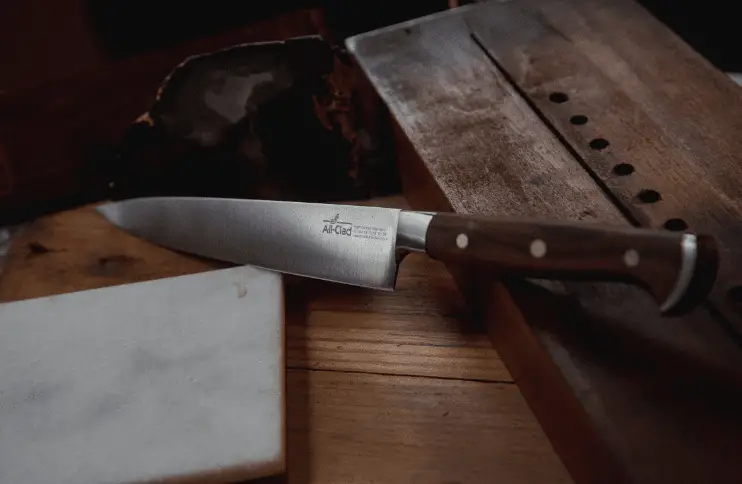
We’ll cover the pros and cons of each wood.
By the end of this guide, you’ll be equipped with the knowledge to choose the best wood for your knife handle to create a functional and stylish tool that will stand the test of time!
Materials Used For Knife Handles & Scales
Knife handles can be made from a variety of materials including:
1. Natural Materials
Wood is one of the most widely used natural materials for knife handles. Hardwoods, like walnut, oak, and ebony are strong and stable, hence, preferred by knife makers for their durability.
Many people prefer exotic woods like African blackwood, koa, and rosewood due to their distinct grain patterns and attractive looks. In addition to wood, other organic substances like bone, horn, and leather can be used for knife handles as well.
2. Synthetic Materials
From carbon fiber and aluminum to titanium, G10, stainless steel, micarta, and fiberglass laminate – many resilient synthetic materials with low-weight construction provide enhanced sturdiness and resistance to cracking.
What Makes a Good Knife Handle Material?
When looking for a reliable knife handle, always see durability, stability, and comfort as three of the primary criteria to consider. These attributes are indispensable for a good-quality handle.
Let’s delve deeper into these elements.
1. Durability
Knife handles should be durable and able to resist regular use without deteriorating. This is especially critical for knives intended for outdoor activities or exposed to moisture.
Some materials such as specific timber and synthetic handle materials stand out for their sturdiness and ability to resist extreme conditions.
2. Stability
The handle of a knife should remain stable and not expand or contract excessively with changes in temperature or humidity.
Handles made from certain types of wood like stabilized wood or materials like G10 or Micarta are known for their stability and resistance to warping or cracking.
3. Comfort
A knife handle should feel comfortable in your hand allowing for a secure grip without causing fatigue or discomfort.
The size, shape, and texture of the handle all play a role in how comfortable it feels to use. Some materials have a natural texture that can make them more comfortable to grip.
Why Is Wood a Popular Choice For Knife Handles?
Wood has become quite a trend when it comes to knife handles. This is due to its natural composition which has been used for many years in making tools and weapons.
It provides a distinct look that is tricky to imitate with synthetic materials. Wood is comparably lightweight and has a natural warmth which makes it more comfortable to hold than some other materials.
Also, its unique texture adds to the overall appeal.
Benefits of Using Wood For Knife Handles
Using wood for knife handles has several benefits:
- Many hardwoods are known for their durability and ability to withstand wear and tear.
- Some types of wood like stabilized wood have been treated to increase their stability and resistance to warping or cracking.
- Wood can be carved or shaped to create a unique handle that fits your style perfectly.
- Different types of wood offer a range of colors, grains, and patterns.
- Wood is very comfortable to hold.
10 Best Wood For Knife Handles (Strong & Durable)
Different wood types have diverse properties that make them suitable for knife handles. The top types of wood used for this purpose are:
1. African Blackwood
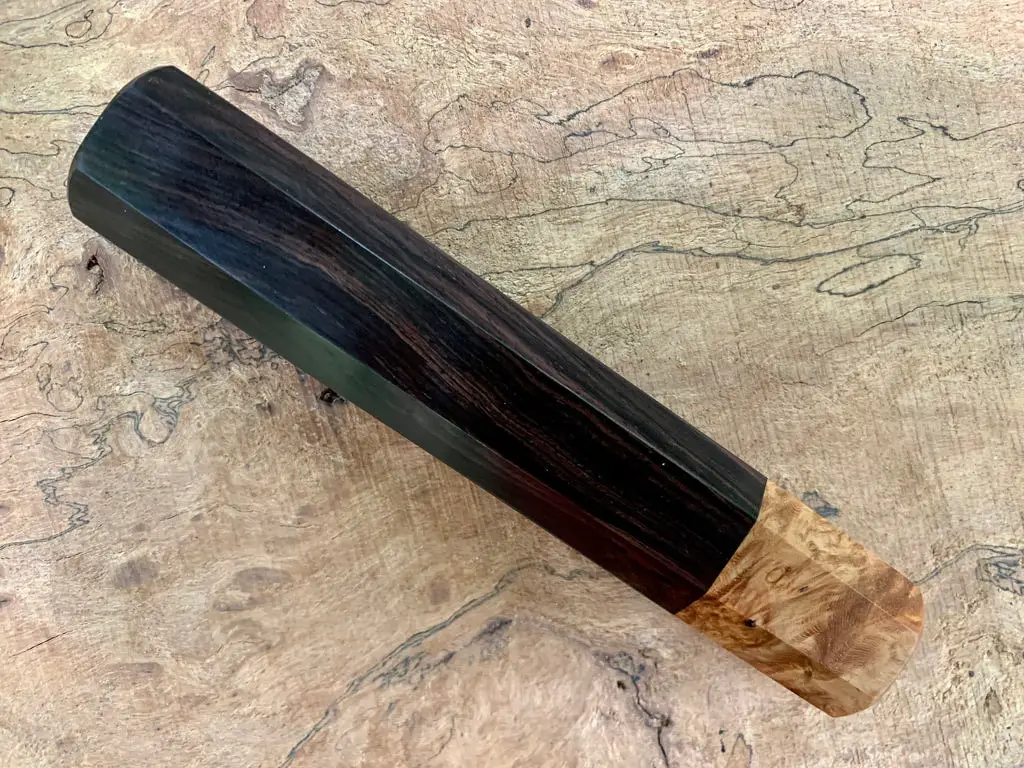
African Blackwood is one of the strongest wood for knife handles. With a density of 1500 kg/m3 and a Janka hardness of 4050, the African Blackwood knife handle is one of the hardest and most durable knives handles available. It is known for its density and extreme durability.
Pros
1. Durability: Wood is known for its durability; hence it is an ideal material for knife handles. It offers superior strength and can tolerate a lot of wear and tear – making sure your knives stay in perfect condition despite continuous use.
2. Density: The high density of African Blackwood makes it resistant to moisture which is a major advantage for knife handles. This helps prevent the wood from warping with time.
3. Aesthetics: African Blackwood is a stunning wood that nearly looks black when polished. Its distinct grainy patterns make it an ideal material for knife makers seeking to produce a remarkably unique style.
Cons
- African Blackwood is an expensive wood, due to its high demand and limited supply. This can make it a less accessible choice for those on a tight budget.
- It is a dense and oily wood that can be difficult to work with. It can be hard to carve and shape, and may require specialized tools to achieve the desired shape.
2. Walnut
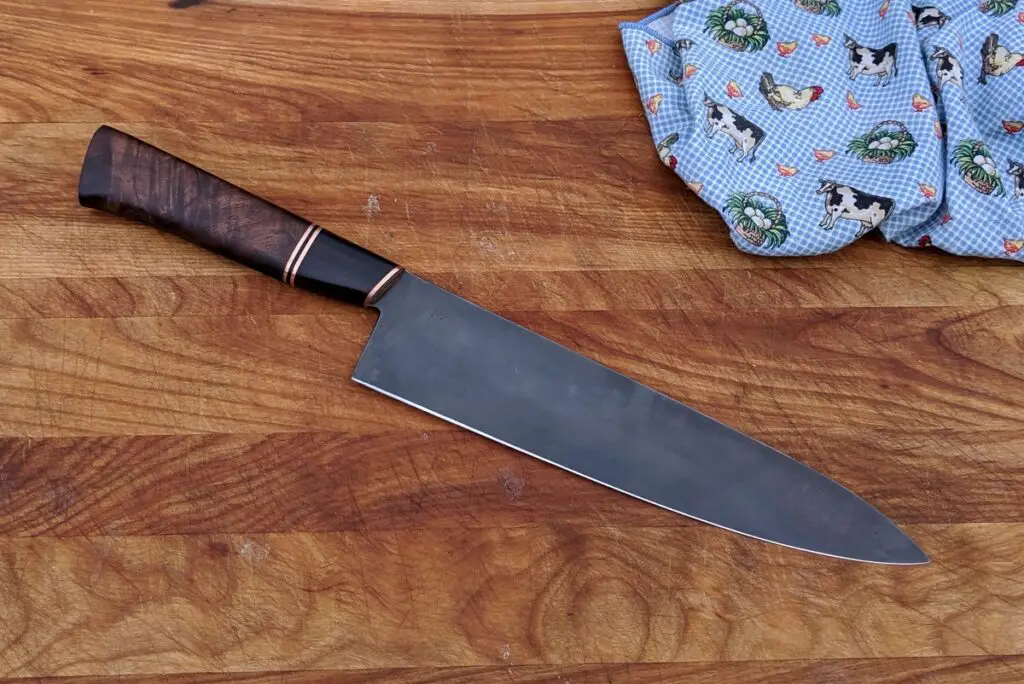
Walnut is an ideal choice for knife handles if you’re looking to craft truly unique and aesthetically pleasing display pieces that won’t see too much use.
Its rich, dark tones make it a great material to work with while its natural strength and durability ensure that even when not used frequently, the handle will stay in pristine condition.
Pros
1. Easy To Work With: Knifemakers favor working with walnut wood due to its relatively simple nature which is one of the primary factors driving its popularity
2. Beautiful Appearance: Walnut wood is admired for its unique straight-grain patterns and dark brown color, giving it a warm touch that instantly adds character to any blade.
Cons
- While walnut wood is durable, it may not be as hard as some other hardwoods like ebony or African Blackwood. This means that it may be more susceptible to denting or scratching.
- Walnut is not the most water-resistant wood; prolonged exposure to moisture can cause it to warp or rot. It may not be the best choice for knives that will be used in humid environments.
- May require stabilizing. Some knife makers may choose to treat the wood to improve its strength and durability. This process can add time and expense to the knife-making process.
3. Oak
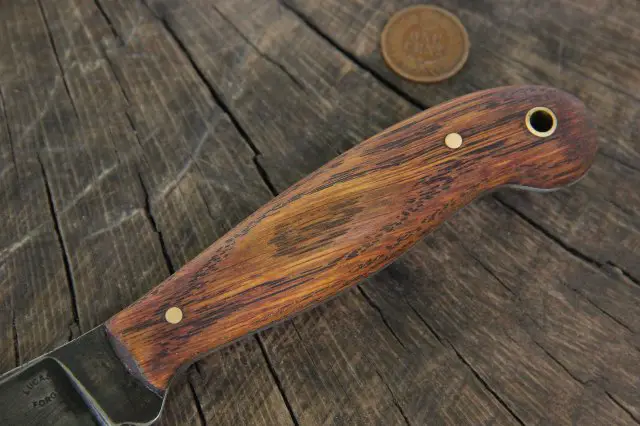
Oak wood is widely used in numerous applications, from furniture to kitchen cabinets to, even gun handles. It’s available in different forms such as red and white oak and has an impressive density ranging from 600-900 kg/m3 with a Janka hardness of 1350 lbf.
Pros
1. Good Durability: Oak is the perfect material for knives that endure long-term usage due to its robust and durable features. It can handle heavy use so it is a reliable choice for knife manufacturing.
2. Aesthetic Appeal: Oakwood is a highly desirable choice of timber because of its striking grain pattern and light beige-to-brown color which can add a unique element of beauty to any knife.
Its stunning looks make it an ideal choice for crafting handles – providing an aesthetically pleasing finish to any knife.
3. Availability: Oak is widely available in many parts of the world and can be relatively affordable. There is generally no shortage of it.
Cons
- Oak has large pores that can absorb moisture and other substances which can affect its stability over time.
- While oak is hard enough to make a durable knife handle, it may not be as resilient as some other woods which could cause wear and tear over time.
- Oak is a very heavy wood. It may not be ideal for some users who prefer a lighter knife.
Oak is an aesthetically pleasing choice for a knife handle, but if you value lightweight and moisture resistance more, it might not be the best option.
4. Ebony
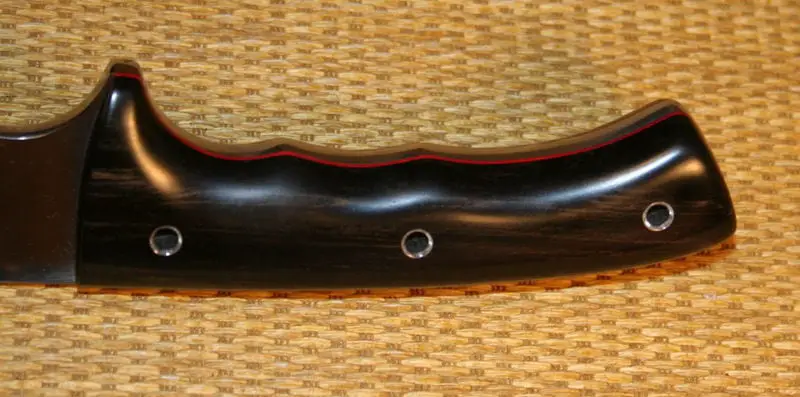
Ebony is a top exotic wood for knife handles. It has a density of 1200 kg/m3 and can resist up to 3220 lbf of force. Before making your decision on using ebony for the handle of your knife, it’s vital to consider its benefits and drawbacks:
Pros
1. Durability: With its dense and hard structure, ebony wood is highly resilient to deterioration hence it is an ideal choice for any application that requires durability.
2. Aesthetics: Ebony wood is a common pick for its striking dark color and its straight or interlocked grain pattern. It is the go-to material for collectors and knifemakers who are looking for superior quality.
3. Stability: Ebony possesses notable stability making it resistant to warping or cracking when exposed to variations in temperature and humidity.
4. Machinability: Despite its density, ebony can be machined with relative ease.
Cons
- Ebony is a prized wood that’s scarce making it costlier than other varieties of wood.
- Ebony dust can be irritating and potentially toxic so it’s important to take proper safety precautions when sanding or shaping ebony knife handles.
- Many ebony species are at risk of extinction due to over-exploitation. To ensure these species are given a chance to survive, it is important to select only reputable sources that practice sustainable forestry.
4. Indian Rosewood
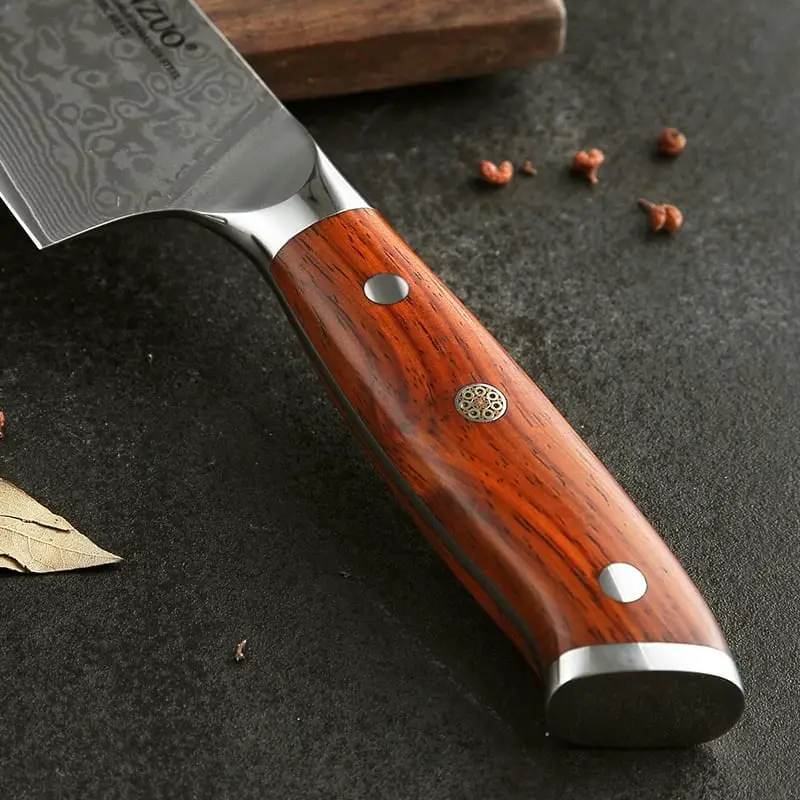
Indian rosewood is the tried and true choice for many knifemakers thanks to its robust composition, vibrant hues, and strong resistance to outside agents like termites.
Its ability to withstand constant use makes it a superior option for any craftsperson.
Pros
1. Beautiful Appearance: Indian rosewood is beloved for its eye-catching golden-brown shade and captivating grain patterns, enhancing the look of any knife handle beautifully.
2. Strength: Indian Rosewood is an incredibly strong timber, boasting a Janka Hardness of 2440 lbf & density of 900 kg/m3. This makes it the perfect wood for applications requiring long-term durability and strength even with heavy use.
3. Easy To Work With: Working with Indian rosewood is simple, owing to its properties.
Cons
- Indian rosewood can be relatively expensive compared to other types of wood, which may make it less accessible to some knife makers.
- It contains oils that can cause skin irritation or an allergic reaction in certain individuals.
- The Indian rosewood tree is classified as “vulnerable” on the International Union for Conservation of Nature’s (IUCN) Red List, so it’s crucial to ensure that the wood is sourced from sustainable forests to minimize the impact on the environment.
6. Desert Ironwood
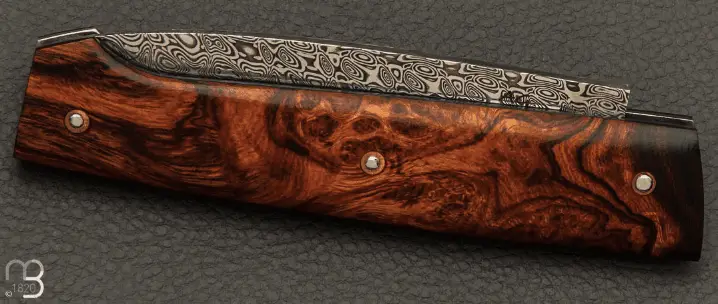
This wood is popular for its hardness and stability. Its color varies from a lighter yellow-orange to a deep red or brown shade. Desert Ironwood knife handle offers great support to long blades due to its weight.
Pros
1. Extremely Hard & Durable: With a Janka hardness of 3260 lbf, desert ironwood is one of the hardest woods available. It’s highly resistant to wear and tear and ideal for knife handles that are used frequently.
2. Beautiful Grain Patterns: Desert ironwood has a rich, reddish-brown color and striking grain patterns that make each knife handle unique.
3. Water-Resistant: Desert ironwood is greatly resistant to water & moisture, thanks to its natural oils, making it a great option for use in humid climates.
Cons
- Desert ironwood is extremely dense and hard, which can make it difficult to shape and finish. It may require specialized tools and techniques to work with.
- Due to its scarcity, desert ironwood is rather expensive compared to other wood types.
- While desert ironwood is resistant to water and moisture, it still requires regular maintenance to maintain its beauty and protect it from damage.
7. Bocote
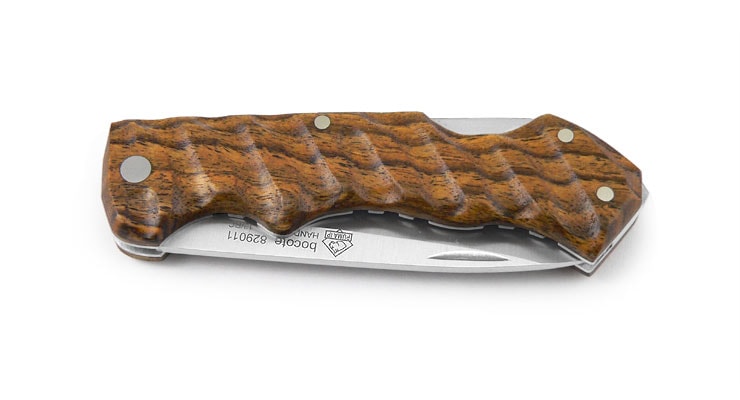
Cordia is not a common tree but it can be found in various parts of Central America and South America. It is treasured for its natural beauty, making it an essential addition to any space.
Pros
1. Aesthetics: Bocote is popular for its beautiful grain patterns, varying from straight to swirling and wavy. The wood has an inviting brown color highlighted with dark stripes that give it a distinctive appearance.
2. Durable: It is an incredibly tough wood that can withstand high levels of use. It has a Janka rating of 2200 lbf, making it highly comparable to the strength of other hardwoods such as hickory.
3. Stability: The wood’s stability and low propensity for warping or cracking make it the ideal material for knife handles which may be exposed to fluctuating temperatures and humidity.
4. Workability: Bocote is relatively easy to work with and can be sanded, carved, and polished to a smooth finish.
Cons
- Although bocote is a great material for knife handles, it is not always readily available like other woods, making it tough to obtain.
- Due to its popularity and limited availability, bocote is a more expensive wood than some other wood options.
8. Cocobolo
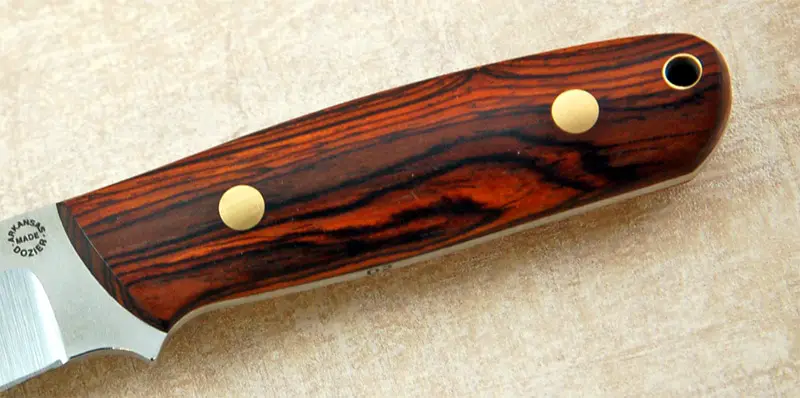
Cocobolo is a celebrated choice for knife handles because it is strong and its oily texture makes it water-resistant. Moreover, its unique beauty offers a great look that appeals to many knife users. It stands out among other tropical hardwoods because of its durability and attractiveness.
Pros
1. Durability: Cocobolo is an excellent wood to use for knife handles because of its strength and density – with a hardness of 1136 lbf and a density of 1095 kg/m3. It is highly durable and can withstand a great deal of wear and tear. This makes it perfect for outdoor & survival knives.
2. Water Resistance: With its natural oiliness, Cocobolo wood can resist water easily. This makes it great for use in damp conditions – there’s no worry about swelling or warping.
3. Aesthetics: The appeal of Cocobolo is incomparable; the shades vary from a deep reddish-brown to a vibrant orange that is unmatched.
Additionally, the unique grain pattern of this wood enhances its overall aesthetic value.
4. Stability: Cocobolo is remarkably stable regarding temperature and humidity variations; the chances of it cracking or splitting are minimal in the long term.
Cons
- People with a sensitivity to the natural oils found in Cocobolo may be subject to skin irritation or difficulty in breathing if they come into contact with it. It’s best to avoid direct contact as much as possible if you have a known allergy to the oils.
- Finding this precious wood can be difficult and it doesn’t come cheap. It is a luxury item that is hard to come by.
- It is a dense and oily wood that can be difficult to work with. It can be hard to cut and shape, and it can cause tool dulling.
9. Merbau
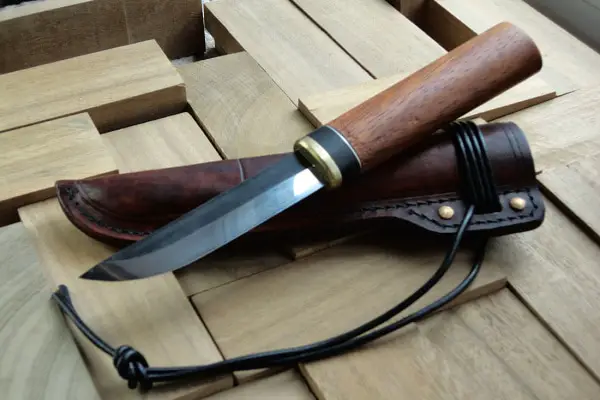
Merbau is an incredibly durable hardwood species native to Southeast Asia and some parts of Australia. This wood is characterized by its reddish-brown hue and can be used in various applications such as flooring and outdoor furniture.
Pros
1. Sturdy: With a density of 880 kg/m3 and a Janka hardness rating of 1712 lbf, Merbau is a very dense wood that provides a sturdy and durable handle for your knife.
2. Water-Resistant: Utilizing Merbau for knife handles can be a wise choice due to its natural water-resistant properties; it is suitable and safe for use in moist conditions.
Cons
- Merbau is a hard and dense wood that can be challenging to work with, especially when shaping and sanding the handle.
- Working with Merbau wood can sometimes be hazardous as a few individuals may turn out to be allergic to its natural oils. Hence, it is crucial to take the necessary safety steps when handling this material in order to stay away from skin inflammation or other health problems.
- Merbau is not as readily available as many other wood types, which can make the process of sourcing it more tedious and costlier than usual.
10. Olive Wood
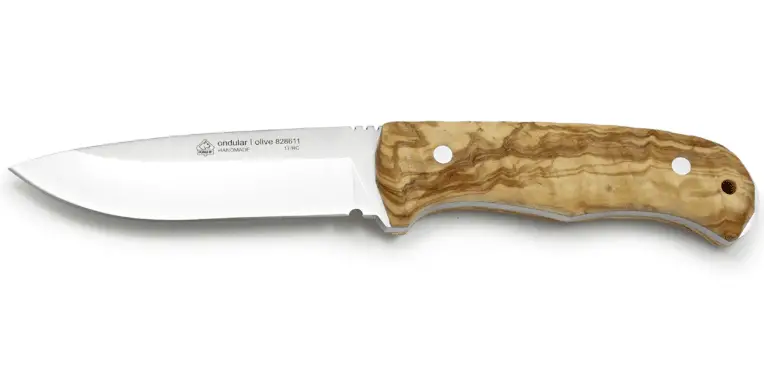
Olive wood has been an integral part of many cultures for thousands of years, owing to its abundance in Eastern Africa, Southern Europe, & the Middle East. It is derived from the olive tree cultivated extensively in these regions.
Pros
1. Beautiful & Unique Appearance: Olive wood is fast becoming a popular material for making unique and eye-catching knife handles due to its distinctive grain patterns and warm color.
2. Dense & Durable: The wood is a dense and strong wood that can withstand heavy use and maintain its structural integrity over time.
3. Natural Antimicrobial Properties: The oil in olive wood has natural antimicrobial properties which can help keep bacteria at bay and make it a more hygienic option for kitchen knives.
4. Sustainable & Environmentally Friendly: Planting olive trees can be a great way to reduce global warming. They take in carbon dioxide from the atmosphere and release oxygen which is beneficial for our planet.
Plus, they require minimal maintenance and have long lifespans. Moreover, they can provide natural shade and help prevent soil erosion, improving air quality as well.
Cons
- Working with Olive wood can be tricky due to its high density & hardness. It requires significant skill to craft it into the desired form.
- Due to its popularity and the difficulty in sourcing it, olive wood is a more expensive option.
Conclusion
Oak, ebony, Indian rosewood, desert ironwood, bocote, cocobolo, Merbau, and olive wood all have their strengths and weaknesses in terms of density, hardness, grain pattern, color, and workability. These characteristics make them excellent choices for knife handles.
However, if we had to choose the best overall wood for a knife handle, we would recommend Desert Ironwood.
Not only is it incredibly hard and durable, but its stunning patterned grain gives it a beauty that truly sets it apart from other woods.
